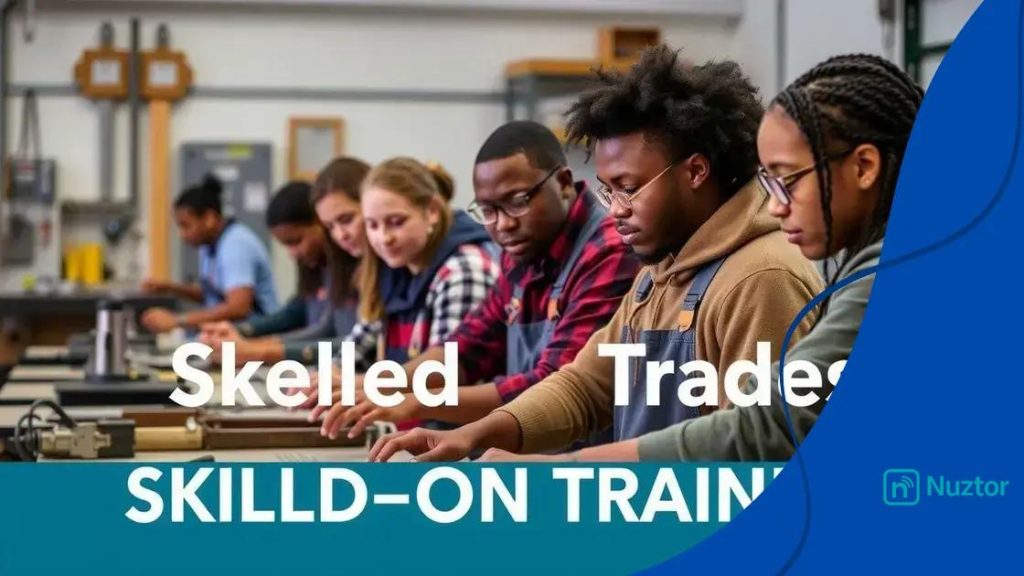Skilled trades education demand is on the rise

The demand for skilled trades education is rising due to industry needs, offering lucrative career opportunities, job security, and the importance of hands-on training in adapting to technological advancements.
Skilled trades education demand is increasing as more companies recognize the value of skilled workers. Have you ever considered how this affects job opportunities? In this article, we will delve into the driving forces behind this demand and what it means for aspiring tradespeople.
Current trends in skilled trades education
Today, the current trends in skilled trades education reflect a significant shift in how we view vocational training. Many individuals are discovering the immense value of these careers. As industries evolve, the need for skilled workers continues to grow.
Recent studies show that students are increasingly enrolling in trade programs, seeking practical skills that align with market demands. The rise of technology has led many educational institutions to adapt their curricula, incorporating modern techniques and tools.
Integrating Technology in Education
One of the most exciting trends is the integration of technology in skilled trades education. Educational providers are utilizing online platforms, virtual simulations, and augmented reality to enhance learning experiences. This modern approach makes education more accessible while allowing students to practice in a safe environment.
Increased Focus on Combating Labor Shortages
Trade schools and programs have amplified their efforts to attract students by addressing the labor shortages we face today. Many regions have launched campaigns showcasing the benefits of pursuing careers in skilled trades.
- High demand for skilled labor in various industries.
- Opportunities for growth and advancement.
- Potential for competitive salaries and benefits.
The demand for skilled tradespeople is evident in construction, plumbing, electrical, and mechanical fields. Employers are often partnering with schools to create apprenticeship programs that provide real-world experience to students.
Expanding Inclusion and Diversity Efforts
Another essential trend in skilled trades education is the commitment to diversity and inclusion. Recent initiatives focus on encouraging underrepresented groups to explore these career paths. Schools are working hard to create supportive environments that promote equity.
This growing awareness results in a more diverse workforce, proving beneficial for industries that need innovative thinking and varied perspectives.
The significant changes happening in skilled trades education today illustrate a promising future. By keeping pace with technology and addressing workforce needs, educational institutions are preparing students not just for jobs but for successful careers.
Importance of hands-on training
The importance of hands-on training in skilled trades education cannot be overstated. This type of training provides students with practical experience that is crucial for success in their careers. Theoretical knowledge is essential, but without the ability to apply that knowledge through hands-on experience, students may struggle to excel in real-world situations.
Many educational programs focus on creating environments where students can work on actual projects. This approach not only enhances learning but also builds confidence. As students tackle real tasks, they develop problem-solving skills that are vital in the workplace.
Benefits of Hands-On Training
Engaging in hands-on training offers several unique benefits. Students can:
- Gain practical skills that employers demand.
- Develop an understanding of safety procedures and protocols.
- Experience teamwork in a collaborative setting.
- Enhance critical thinking and adaptability.
These benefits make hands-on training an essential component of any skilled trades program. When students have the chance to learn by doing, they not only gain skills but also grow their passion for their chosen fields.
Adapting to Industry Needs
Furthermore, hands-on training helps students adapt to industry needs. Many trades are rapidly evolving due to technological advancements. By engaging in practical training, students can stay updated with the latest tools and techniques used in their industries. They become more competitive candidates in the job market, as they are familiar with current trends.
Moreover, employers highly value candidates who have participated in hands-on training programs. These candidates often come with a clearer understanding of the challenges and demands of their jobs. This readiness makes them more appealing to hiring managers.
Incorporating hands-on training into skilled trades education ensures that students leave their programs equipped with the skills and confidence they need to succeed in today’s dynamic job market.
Career opportunities in skilled trades

Exploring career opportunities in skilled trades reveals a world of possibilities for those willing to learn and work hard. Skilled trades offer jobs that are both rewarding and in high demand across various industries. From construction to automotive services, the options are plentiful.
Many people underestimate the potential of skilled trades careers. However, they can lead to fulfilling and lucrative positions. As industries continue to grow, employers are on the lookout for qualified candidates to fill these roles.
In-Demand Skilled Trades
Some of the most sought-after trade careers today include:
- Electricians: Responsible for wiring and lighting systems.
- Plumbers: Handle installation and maintenance of pipes.
- HVAC Technicians: Specialize in heating, ventilation, and air conditioning.
- Welders: Work with metal to join parts together.
These professions often provide competitive salaries and opportunities for advancement. As technology incorporates into these fields, the demand for skilled workers grows even more.
Benefits of a Career in Skilled Trades
Pursuing a career in skilled trades offers many advantages. Some key benefits include:
- High earning potential compared to the cost of education.
- Stable job opportunities in a variety of sectors.
- Possibility for self-employment and entrepreneurship.
- Hands-on work that keeps every day interesting.
The skill set gained through hands-on training and practical experience makes graduates of skilled trades programs highly employable. Furthermore, the shortage of qualified tradespeople means that job security is often guaranteed.
Many trade jobs offer excellent benefits, such as health insurance and retirement plans, making them even more attractive. This combination of demand, pay, and job satisfaction makes skilled trades a viable career path for many.
Challenges faced in skilled trades education
The challenges faced in skilled trades education are diverse and impact both students and institutions. As the demand for skilled workers grows, it is essential to address these challenges to ensure effective training and education.
One of the primary issues is the perception of vocational training. Many people still view skilled trades as less prestigious compared to four-year degrees. This mindset can discourage potential students from pursuing careers in trades. Changing this perception is crucial for attracting more individuals to these vital roles.
Funding and Resources
Another challenge is the lack of funding for trade programs. Many educational institutions struggle to provide the necessary tools and materials for hands-on training. When schools do not have updated equipment, students miss out on learning the latest techniques. This lack of resources can create a gap between training and industry needs.
Instructor Shortages
Additionally, there is a shortage of qualified instructors in skilled trades education. Finding experienced professionals who can teach and share their knowledge is often difficult. This shortage can lead to large class sizes and less individualized attention for students.
Moreover, keeping curriculum up-to-date with current industry standards presents another hurdle. Skilled trades are constantly evolving due to advancements in technology. Programs must regularly revise their coursework to ensure that students learn relevant skills. This requires ongoing investment and commitment from educational institutions.
Lastly, there are challenges related to student retention in trade programs. Some students may drop out due to financial constraints or lack of support. Creating a supportive environment where students feel encouraged can help improve these retention rates.
Addressing the challenges in skilled trades education is important. By improving perceptions, providing better resources, and supporting instructors and students alike, we can ensure a stronger workforce in the skilled trades.
Future outlook for skilled trades professionals
The future outlook for skilled trades professionals is bright and full of potential. As the demand for skilled workers continues to grow, those entering these fields can expect numerous job opportunities. Industries are evolving, and with that evolution comes the need for trained professionals who possess the right skills.
Many factors contribute to the optimistic outlook for skilled trades. First, technological advancements are reshaping the landscape of work. For example, fields such as electrical, plumbing, and HVAC are incorporating new technologies that require workers who are equipped with modern training. This means that ongoing education and upskilling will be essential.
Rising Demand
The demand for skilled tradespeople is projected to rise significantly in the coming years. Various industries, including construction, manufacturing, and energy, depend on skilled workers to operate effectively. As older workers retire, there will be even more opportunities for young professionals to step in and fill these gaps.
- Increased construction projects due to population growth.
- Emerging technologies in renewable energy creating new job roles.
- Advancements in automation requiring skilled technicians.
Furthermore, many trades offer the possibility of self-employment or entrepreneurship. Skilled tradespeople can start their own businesses, providing services directly to consumers or other businesses. This entrepreneurial aspect appeals to many individuals seeking independence and flexibility in their careers.
Job Security and Stability
Another critical point is the job security that comes with skilled trade professions. Shortages in certain trades leave a gap that ensures steady employment. These roles often weather economic downturns better than many other job sectors, providing professionals with more stability during challenging times.
Overall, the landscape for skilled trades professionals is changing positively. With both the rising demand and the need for continuous learning, individuals in skilled trades can look forward to a rewarding and stable career ahead. This highlights the importance of pursuing education and training in these valuable fields.
FAQ – Frequently Asked Questions about Skilled Trades Education
What are the main benefits of pursuing a career in skilled trades?
Pursuing a career in skilled trades offers high job demand, competitive salaries, hands-on training, and opportunities for self-employment.
Are skilled trades jobs secure during economic downturns?
Yes, skilled trades often provide job security, as many industries continue to need qualified workers even during economic challenges.
How important is hands-on training in skilled trades education?
Hands-on training is crucial in skilled trades education, as it allows students to apply their knowledge practically and develop essential skills.
What challenges do skilled trades education programs currently face?
Challenges include funding limitations, instructor shortages, and the need to update curricula to keep up with industry advancements.